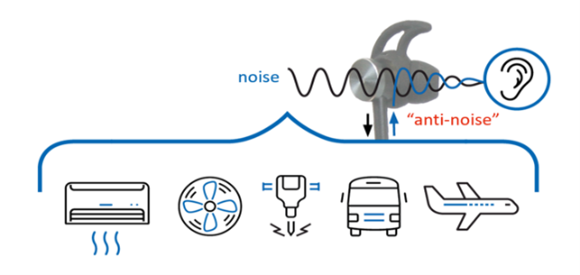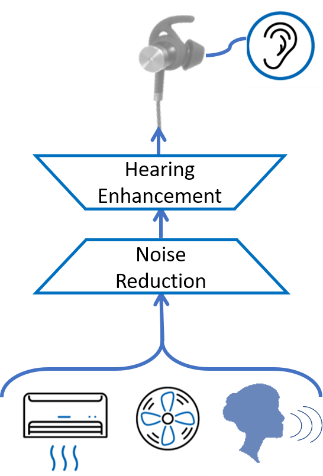Active Noise Cancellation vs. Noise Reduction
April 15, 2019What is the Difference, and Which Technology is Used in BeHear and Why?
Even before this article came out comparing the BeHear with Bose Hearphones we received inquiries about how our products enhance hearing in noisy places. There seemed to be some confusion about how two leading technologies – Active Noise Cancellation (ANC) and Noise Reduction – work in headphones in general, and whether they are used in the Wear & Hear line of assistive hearing products. Because ANC is a much-heralded feature in high-end Bluetooth headphones, many people were curious to know why we do not use it in our BeHear Bluetooth headset with personalized hearing enhancement. Our engineers have contributed the following texts in an attempt to clarify our choice.
How Does ANC Work?

In the process of ANC a microphone is used to monitor the environmental noise in order to create an “opposite” sound wave with an inverted phase. This anti-wave is reproduced via the earpiece and mixed with the original acoustic sound wave to cancel out the noise before it reaches the user’s ear.
What Happens in the Hearing Enhancement Process?

In the hearing enhancement process a microphone is also used to pick up the environmental sound. This sound is amplified based on the specific hearing requirements of the user and then the processed, slightly delayed output sound is reproduced via the earpiece.
As a result, this hearing-enhanced (amplified) sound actually masks the direct environmental sound wave causing the hearing-impaired user to hear mainly the enhanced sound reproduced by the earpiece, and not the acoustic waves coming from the environment.
Why ANC and Noise Reduction Cannot be Employed Simultaneously
The two methods – ANC and hearing enhancement – are conceptually contradictory. The conflict arises from both acoustic and methodology contradictions. Acoustically, since the same “monitoring” microphone is used by both the ANC and hearing enhancement technologies to pick up the environmental sound, the two signals – the immediate ANC anti-wave and the slightly delayed hearing-enhanced wave – may produce an unpleasant acoustic effect known in physics as “wave beats” when the two signals are mixed together in the user’s ear. Another conflict arises from the fact that one technology (ANC) tries to achieve noise reduction by sending the anti-wave, while the other (hearing enhancement) tries to substitute the direct acoustic sound with its enhanced and amplified version, making the ANC anti-wave obsolete.
For the reasons explained above, ANC is not applied in the BeHear headset. Instead, and in order to clarify the speech in noisy environments, BeHear applies a dedicated noise reduction technology to the hearing-enhanced sound, thus making the sound perceived by the user significantly less noisy. Additionally, BeHear allows the user to control the amount of noise reduction applied – a feature that is not available to users of ANC.
The Choice is Clear for Assistive Hearing Products
Bottom line:
We don’t think ANC is important for our target user given its irrelevance when combined with hearing enhancement technology. Furthermore, we didn’t want to increase the product price by introducing a feature that would increase the cost of the device without providing a substantial benefit to our users.
Alango Wear & Hear Development Team
For more information about our Wear & Hear line of assistive hearing products visit the products page of our Web site.

